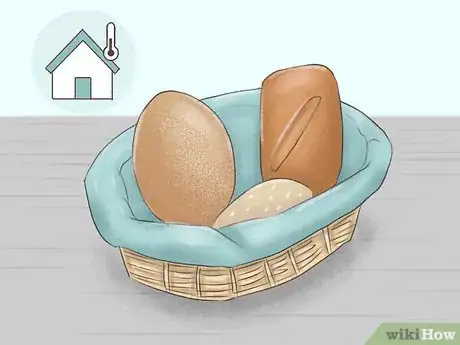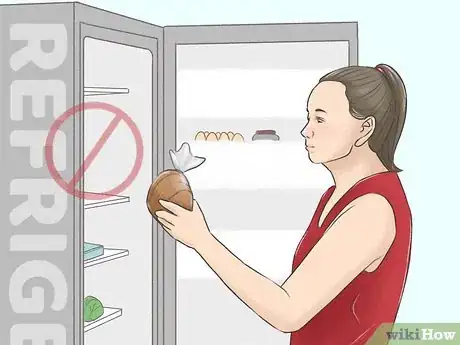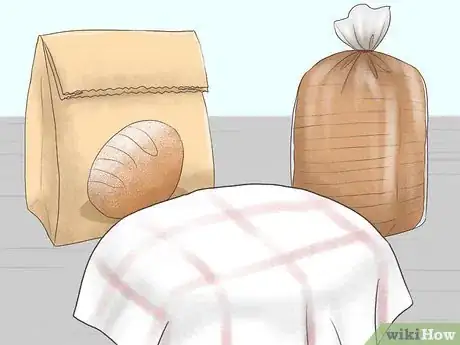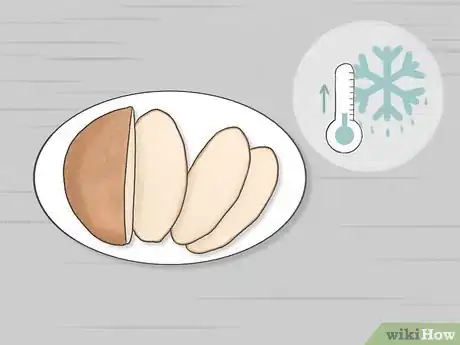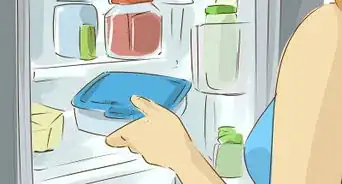X
wikiHow is a “wiki,” similar to Wikipedia, which means that many of our articles are co-written by multiple authors. To create this article, volunteer authors worked to edit and improve it over time.
This article has been viewed 40,629 times.
Learn more...
If not stored properly, bread can go bad very quickly. With just a little bit of experimentation and practice, you can learn the different tips and tricks involved in storing different kinds of breads.
Steps
-
1Store the bread at room temperature. Make sure that you keep your bread at a normal room temperature – preferably at 68 degree Fahrenheit or 20 degrees Centigrade. Ensure that it is kept away from direct sunlight in a dry and cool place.
-
2Avoid storing the bread in the refrigerator. Scientific tests have shown that storing breads in the refrigerator sucks out all the moisture from them thereby making them stale at a faster pace. This happens as result of a process known as “retrogradation” wherein the starch molecules start to crystallize together.Advertisement
-
3Pick a storage option based on the type of editor. There are a few rules of thumb that you can use while storing and packaging different kinds of breads. These are as follows.
- Sandwich breads should be stored in plastic bags. Breads that are processed and sold as slices usually come pre-packed in plastic bags. As advised by manufacturers themselves, these sandwich breads should be stored in the plastic bags to retain their moisture. Even though moisture-laden plastic bags aid in the development of mold, these breads come with preservatives that slow down the early onset of mold growth.
- Artisanal breads should be stored in paper bags. Artisanal breads remain crispy when stored in paper bags. Bakers that make crusty artisanal breads swear by this mantra. Storing these breads in a plastic bag will only make the crispiness turn spongy.
- Use foil to protect the sliced ends of freshly baked breads. Foil is a great material to keep the sliced ends of freshly cooked bread soft.
- Artisanal breads can also be left out in the open. Unsliced bread can be left on the counter with the cut side facing down. This is a tested method for home cooked bread or freshly cooked bakery breads. Cover the bread with a kitchen cloth to protect it for a longer time.
-
4Freeze leftovers. Leftover bread should be frozen to prevent it from going stale. Slice the bread before freezing. Store it in an airtight freezer bag or wrap it in foil.
-
5Thaw the frozen bread properly. Frozen bread would require room temperature thawing bread basket and thaw it properly. You can also toast it in the oven for a little while – not more than five minutes – to regain its crispiness.
Advertisement
Community Q&A
-
QuestionDoes vacuum packing help prevent freezer burn?
 Community AnswerYes, it does. Freezer burn occurs when liquid is lost from the frozen item, so having a very secure packaging will prevent water loss and, therefore, freezer burn.
Community AnswerYes, it does. Freezer burn occurs when liquid is lost from the frozen item, so having a very secure packaging will prevent water loss and, therefore, freezer burn.
Advertisement
About This Article
Advertisement
